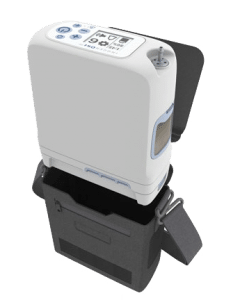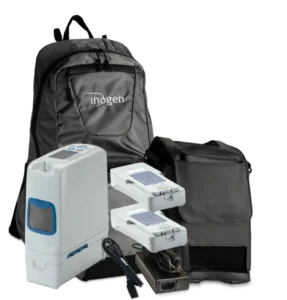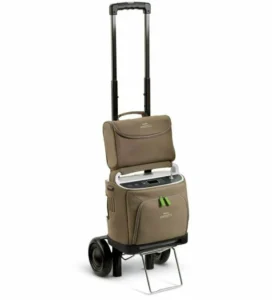A portable oxygen concentrator is a lifeline for many people with respiratory disease. Some patients may need one for the long term, others might only use one while recovering from an injury or a bout of pneumonia. You can rent or buy a portable oxygen concentrator to suit your needs. You might be wondering how to choose a portable oxygen concentrator.
Portable oxygen concentrators give patients more freedom and independence. You can use them when visiting friends or traveling.
If you need a portable oxygen concentrator, talk to your doctor. This will help you make a good choice. You want to get the device that meets your needs.
If you are a doctor, you must help your patients choose the right oxygen concentrator. This should fit their needs and lifestyle.
Core Criteria When Choosing a Portable Oxygen Generator
Choosing a portable oxygen concentrator aims to meet the patient’s medical needs and allow them to be as independent as possible. Here’s what to consider before buying an oxygen concentrator.
A. Oxygen Output and Delivery Settings
First, portable oxygen contractors come in two flow types: continuous and pulse. Continuous generators produce oxygen, while pulse generators produce it in response to the user’s breathing.
Pulse generators use less energy and oxygen and are smaller and lighter. However, pulse units may not register your breath when in deep sleep and are thus unsuitable for sleep use.
They may also not register breath taken with the mouth. They can, however, produce more oxygen during exertion. Pulse generators are usually helpful when you run errands or visit friends. However, they are not great for travel.
 You must also examine the flow range, settings, and oxygen purity. Each of these reflects your or your patient’s medical needs.
You must also examine the flow range, settings, and oxygen purity. Each of these reflects your or your patient’s medical needs.
Some patients may need higher flow or purity to maintain saturation properly. On the other hand, you don’t want your concentrator to be wasting oxygen by overproducing. People with chronic respiratory issues typically require more oxygen than those with a short-term condition.
B. Battery Life and Portability
When looking at portable concentrators, you should directly compare hours of usage per charge. Make sure these suit your lifestyle. You might need a smaller battery if you rarely travel or stay close to home. A smaller battery is usually lighter and easier to carry.

If you often take long drives or flights, ensure your battery lasts longer than the trip time. You should also plan for possible delays. Battery life can range from 3 to 12 hours; you can also carry an extra backup battery.
Some patients prefer to use a portable concentrator during the day at home and thus may need battery life for full-day support. Others may only want to use it for occasional runs to the store.
C. Weight and Design
Weight is an important consideration for many patients. Older users might not have the strength to carry a larger unit. Patients who are more mobile may also prefer something lighter. A patient who usually uses a power chair or travels with a healthy caregiver may handle a higher weight.

Many oxygen concentrators come with a carry case. A backpack is great for mobile users or for slinging over the back of a manual wheelchair. Look at the types of cases available and their accessories. Some concentrators have wheels, and people can tow them like a roll-along suitcase.
D. Noise Levels
All portable oxygen concentrators make some degree of noise. A noisier one may be fine if you only use your concentrator during the day, such as when running errands or driving.
If you travel overnight and plan to sleep with your concentrator, especially in shared spaces, choose a quiet one. Quieter concentrators are helpful for many daily activities.
 They help when going to a movie or live show, facilitate long conversations, and are great for shared and public spaces.
They help when going to a movie or live show, facilitate long conversations, and are great for shared and public spaces.
Look for a concentrator that lets you talk at a normal volume. Shouting can strain your lungs. Always listen to the device before buying.
E. Maintenance and Warranty
Portable oxygen concentrators require some maintenance. You should change filters every 3 to 6 months. Run POCs that do not occur daily from time to time. They must also keep them clean and rotate the batteries evenly to ensure even wear.

Look at the maintenance needs and make sure they’re manageable. Also, consider the length of the warranty. You don’t need an extended warranty if you only need a concentrator for three months.
Finally, look at the availability of post-purchase technical support. What happens when you send your unit in for repairs? Will they provide a loaner unit?
Top Portable Oxygen Concentrators Compared
No one “best” portable oxygen concentrator exists. The choice depends on your or your patient’s medical needs and lifestyle. However, here are some of our top picks for oxygen concentrator comparison.
1. AirSep Focus ($999.00)
The AirSep Focus is currently the lightest oxygen concentrator on the market. The unit weighs 800 grams and the battery 240 grams.
You can wear them both, but you must wear them separately. You can get a carrying case and add the 800-gram AirBelt for an additional battery. Each battery provides 1.5 hours, and the AirBelt offers 4 more hours, for a total of 7 hours.

In theory, you can get extra batteries for more use. However, you must switch the battery manually when the first one runs out. You can recharge from a car charger or the mains.
Thus, you could recharge a battery in a car or airplane with power to the seat. It is FAA-approved.
One advantage is that the AirSep Focus is discreet. It doesn’t look like a medical device. And because it’s light and wearable, it works in all active situations.
However, the designers created the AirSep Focus for patients needing only extra oxygen. A pulse device provides a low maximum flow rate (pulse setting 2), so it’s mostly suitable for patients with mild medical needs.
2. CAIRE FreeStyle Comfort ($1,395.00)
The CAIRE FreeStyle Comfort portable generator is also lightweight and wearable. Its curved design provides comfort. It is the size of a book and weighs only 2.3kg.
While this is much heavier than the AirSep, it’s still lighter than the average purse. It is quiet and has a longer battery life.
You can get an 8-cell battery that lasts 8 hours or a 16-cell pack that lasts up to 16 hours. These estimates are for the lowest setting. It has a discreet carrying bag and AC and DC power inputs.

It also works as a pulse dose. It delivers automatically when the device detects no breath. This lets users use it while they sleep, and it stays quiet.
It has a flow setting of up to 5. If you need a higher setting, you will use more battery, so you might have to buy and carry extra batteries. As an option, you can get a backpack, shoulder-strap carrying bag, and/or carry-all accessory bag.
This device is best for people with lower oxygen needs. It works well for active patients and those who travel often. It is also a great choice for a quiet oxygen machine. It is FAA-approved.
3. Inogen One G5 Portable Oxygen Concentrator ($1,695.00)
This POC goes up to 6 on the pulse scale. The Inogen One G5 is one of the Inogen models. They also have the cheaper G4 for a pulse rate of 3 or less. If your rate is only 1 or 2, you might want to consider the AirSep Focus instead.
The G5 can last up to 13 hours on setting 1 with a second battery. However, battery life decreases with higher usage. It only comes with one battery as standard. Also, they are phasing out the model, which may result in service issues.

If you need more battery life, you may need to buy extra batteries, which can be expensive. It comes with a custom bag; you can also get a backpack. It has an app connection and is quiet.
It also needs a bit more care. You should clean the filter every week and replace the cannula when needed. It is FAA-approved.
4. Inogen One Rove 6 Portable Oxygen Concentrator ($2,095.00)
The Rove 6 replaces the G5 and is similarly compact and portable. It has the same dose settings of 1 to 6. However, it has Intelligent Delivery Technology to optimize oxygen delivery.

However, the battery life is slightly less. The double battery lasts 12 hours and 45 minutes on setting 1 (one battery gives 6 hours). It also takes a full 8 hours to recharge. If you’re traveling, you’ll want at least two battery packs.
Otherwise, it’s similar to the G5 and has the same accessories. The same backpack is carrying the same battery and works for both units. You can also get a pull cart, which is helpful for old patients who might struggle to carry or wear the unit. It is also FAA-approved.
5. Respironics SimplyGo Portable Oxygen Concentrator ($1,999.00)
Unlike the other concentrators we have listed, the SimplyGo can be set for pulse and continuous flow. This means you can use it when asleep without problems, and one of the two models goes as high as 11.

This is thus the only reasonable option for people with high oxygen needs or who use a CPAP machine. Many patients use this as both their home and portable concentrator. It has a sleep mode.
The SimplyGo Mini goes up to five. Much smaller, it only provides pulse. It weighs just five pounds.
In comparison, the regular SimplyGo weighs ten pounds, which may be too heavy for some patients. The manufacturer makes it easier to carry by providing a shoulder strap, a carrying case, a foldable wheeled cart, and an accessory bag.
The downside is the short battery life. The SimplyGo offers only 3.4 hours of battery life, but an extended battery can double it.
The Mini has 4.5 hours. The battery only lasts an hour on continuous flow and takes at least two hours to recharge. Most patients typically run it directly off the mains when sleeping.
One of these top choices should work well for you or your patient. The best portable oxygen concentrator depends on your lifestyle, oxygen needs, and the amount of weight you’re willing to carry.
When deciding which portable concentrator is best for you, talk to your doctor first. They can help you understand what you need to stay healthy and independent.
FAQs
Can I fly with a portable oxygen concentrator?
You should be able to fly with a POC if it is FAA-approved and on all our top lists. However, some airlines do not allow POC use on smaller regional jets.
They also require enough battery life for 1.5 to 2 times your flight’s duration. This may mean carrying extra packs and putting them in ziplock bags to prevent short-circuiting. You can fly with other oxygen therapy equipment, but check with your airline.
Is a prescription required?
Yes. You typically need a prescription to purchase a portable oxygen concentrator. You should also work with your doctor to choose the right machine.
What’s the difference between home and portable units?
Portable units are smaller and lighter. Home units may not have a battery.
If your power is unreliable, get a home unit with a battery backup. You can also keep your portable unit charged as a backup. You can charge some portable units off your car if needed.



